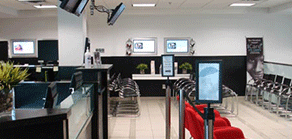Corneal Abrasions & Erosions: Explanation & Treatment Options
What is the cornea?
The cornea is a dome-shaped, transparent tissue, which acts as the front window of the eye, covering approximately the width of the coloured iris. It plays a vital role in focusing light onto the back of the eye, allowing us to see. Our cornea is made up of three major layers: the outside, epithelial layer, the middle, or stromal, layer and the inner, endothelial layer. The outermost layer, the epithelium, rests on a basement membrane. These structures can become compromised, either from traumatic injury or underlying pathology, resulting in a corneal abrasion or erosion.
What is a corneal abrasion?
A corneal abrasion usually results from an injury such as a scratch or a cut to the epithelium. Many things can cause the abrasion, ranging from fingernail cuts, scrapes from tree branches or makeup brushes, even rubbing the eyes too aggressively. Some eye conditions, like diabetes and dry eye, can increase the chance of an abrasion.
What are the symptoms of a corneal abrasion?
Corneal abrasions are usually painful and result in a trip to seek medical attention. Symptoms usually include:
1. Sharp pain
2. Light sensitivity
3. Eye redness
4. Tearing
5. Blurry vision
6. The sensation of something in the eye
How is a corneal abrasion diagnosed and how is it treated?
An ophthalmologist will typically use a special microscope (i.e. slit lamp) and a special dye called fluorescein to determine if an injury to the corneal epithelium exists and the extent of it.
There are a variety of treatment options for a corneal abrasion including:
1. Patching the eye to help with healing.
2. Eye drops to prevent infection and lessen pain.
3. Wearing a contact lens to help with healing.
Fortunately, the cornea is extremely resilient and heals quickly. Minor abrasions usually close within a day or two. It is important not to rub the eye during this time and avoid makeup or prescription contact lenses in order to maximize healing.
What is corneal erosion?
A corneal erosion is caused by a loose attachment of the epithelium to its underlying basement membrane which lies directly above the stroma. Usually this occurs in an area of prior corneal trauma and can occur spontaneously, such as awakening in the morning. Inherited eye conditions causing deposits in the cornea such as granular or lattice dystrophy can also create these loose attachments and predispose a patient to a corneal erosion. A thorough eye exam by your ophthalmologist can ensure you do not have these inherited conditions. Symptoms of a corneal erosion are similar to a corneal abrasion.
How is corneal erosion treated? What is phototherapeutic keratectomy?
Initial treatment is similar to a corneal abrasion (see above). However, a diagnosis of corneal erosion signifies an ongoing issue with the cornea and typically requires treatment to help minimize or eliminate future occurrences.
One longer term treatment option, ‘anterior stromal micropunture’, involves making tiny, superficial ‘pot holes’ on the surface of the cornea over the area of corneal damage. This promotes stronger attachments between the epithelial cells and the basement membrane underneath.
Sometimes an eximer laser can be used for corneal erosions in a procedure called Phototherapeutic Keratectomy (PTK). This procedure removes the corneal epithelium and superficial opacities, removing a very minute layer of the cornea. This, in theory, allows the cornea to regenerate in a more smooth fashion. This is generally an in-office procedure which takes about 15-20 minutes to perform.

